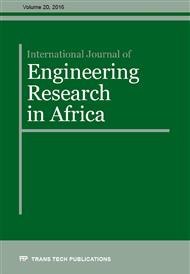[1]
Palanikumar K., Pandurangadu V., and Syed Altaf Hussain S.A., (2011)Machinability of glass fiber reinforced plastic (GFRP) composite materials,. International Journal of Engineering, Science and Technology, Vol. 3, No. 4, pp.103-118.
DOI: 10.4314/ijest.v3i4.68546
Google Scholar
[2]
Palanikumar K., Pandurangadu V., and Syed Altaf Hussain S.A., (2011).
Google Scholar
[3]
Palanikumar K., Pandurangadu V., and Syed Altaf Hussain S.A., (2011). Machinability of glass fiber reinforced plastic (GFRP) composite materials,. European Journal of Scientific Research, ISSN 1450-216X, Vol. 41, No. 1, pp.84-98.
DOI: 10.4314/ijest.v3i4.68546
Google Scholar
[4]
K. Palanikumar, (2007). Modeling and analysis for surface roughness in machining glass fibre reinforced plastics using response surface methodology,. Materials and Design 28, p.2611–2618.
DOI: 10.1016/j.matdes.2006.10.001
Google Scholar
[5]
K. Palanikumar. J. Paulo Davim, (2007). Mathematical model to predict tool wear on the machining of glass fiber reinforced plastic composites,. Materials and Design 28, p.2008-(2014).
DOI: 10.1016/j.matdes.2006.06.018
Google Scholar
[7]
Adam khan. M and A. Senthil kumar, (2011) Machinability of glass fiber reinforced plastic (GFRP) composites using aluminabasedceramic cutting tools,. International Journal of Manufacturing Process. Vol. 13, No. 1, pp.67-73.
DOI: 10.1016/j.jmapro.2010.10.002
Google Scholar
[8]
S. A. Hussain, V. Pandurangadu, K.P. Kumar and V.V. Bharathi., (2011). A Predictive Model for Surface Roughness in Turning Glass Fiber Reinforced Plastics by Carbide Tool (K-20) Using Soft Computing.
Google Scholar
[9]
Jordan Journal of Mechanical and Industrial Engineering, Vol. 5, No. 5, ISSN 1995-6665, Pages 433 – 438.
Google Scholar
[10]
Meenu.,H.K. Sardana.,P.S. Satsangiand Surinder Kumar; (2011).
Google Scholar
[11]
Palanikumar, K,. (2008).
Google Scholar
[12]
Cheng Y, Huang B, Tsai J (2009). Enhancing Fracture Toughness of Glass/Epoxy Composites by Using Rubber Particles Together with Silica Nanoparticles,. Journal of Composite Materials. 43(25). pp.3107-3123.
DOI: 10.1177/0021998309345299
Google Scholar
[13]
Takeyam. H and Ikutoku (1998), Machinability of Glass fiber reinforced Plastics And Application of Ultra Machining, Annals of the CIRP 37/1, 93-96.
Google Scholar
[14]
Konig W, Wulf. Ch, Grab P., (1985) Machining of fiber Reinforced Plastics, Annals of CIRP, 34, 537-548.
DOI: 10.1016/s0007-8506(07)60186-3
Google Scholar
[15]
Evestine G. C And T.G. Rogers (1971), Theory of Machining of Fiber Reinforced Materials, J. Composite Materials, 5, 94-106.
Google Scholar
[16]
Santhanakrishnan G, Krishnamurthy R, and Malhotra.S. K (1988) Machinability Characteristics of Fiber Reinforced Plastics Composites, Journal of Mechanical WORKING Technology. 17, 195-204.
DOI: 10.1016/0378-3804(88)90021-6
Google Scholar


